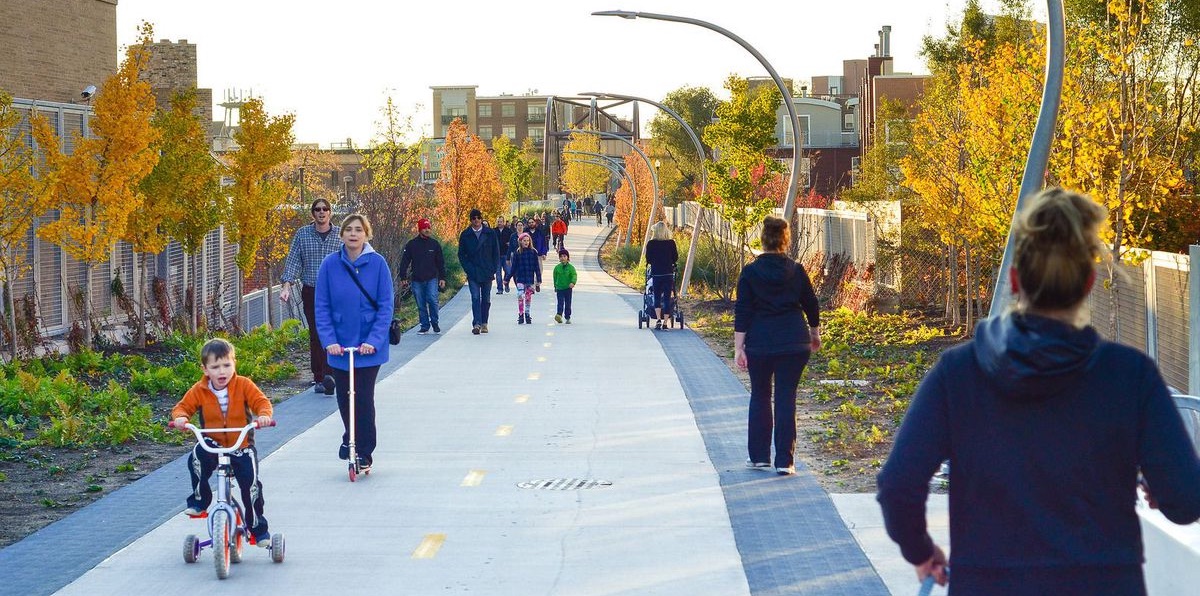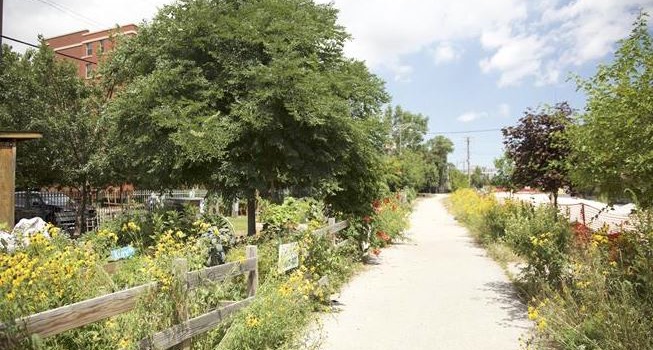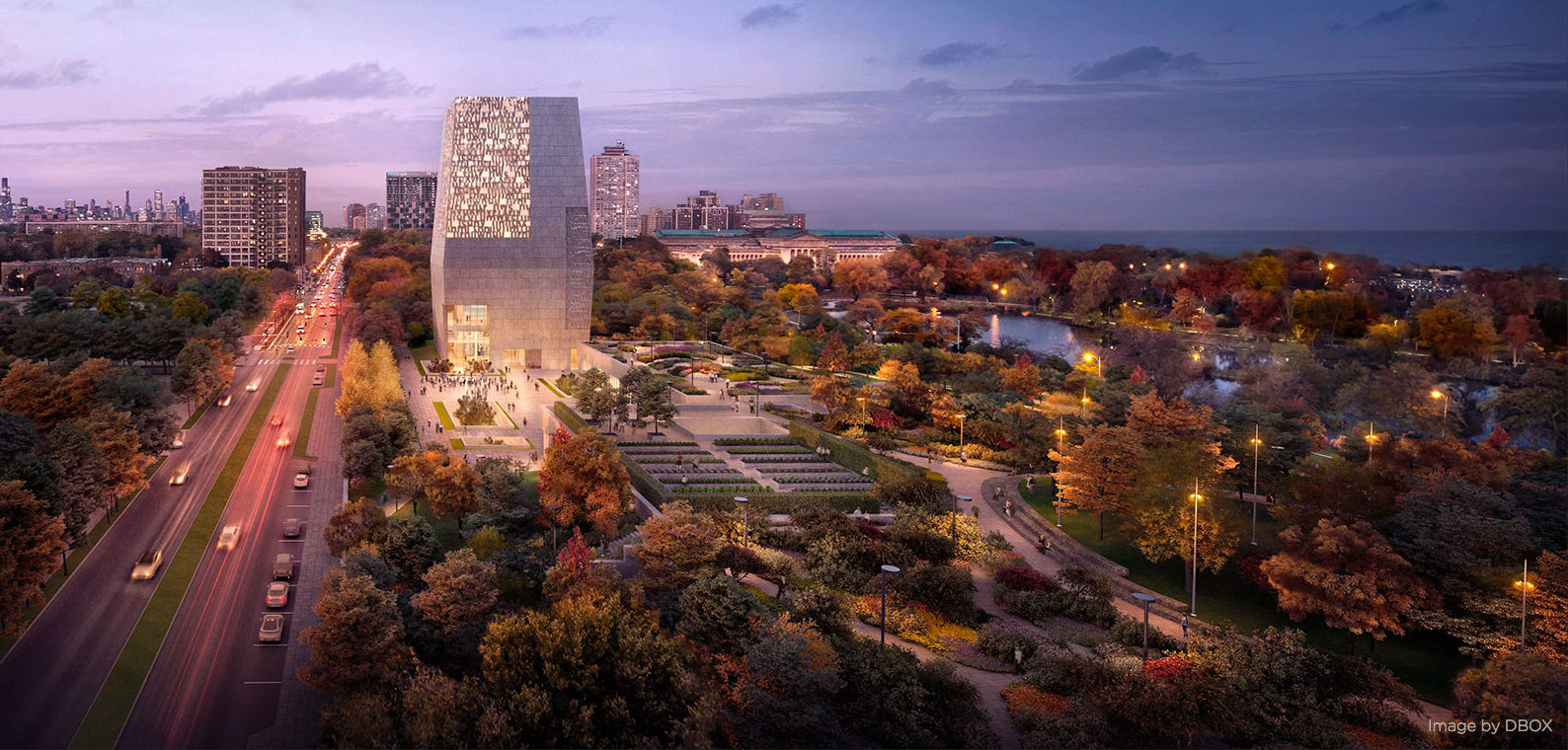Lower-cost neighborhoods with vulnerable populations and rising prices (Dark blue)
Neighborhoods in this category include a number of neighborhood pockets well-served by rapid transit or bordering moderate-cost areas including Austin, North Lawndale, west Woodlawn, Englewood and West Englewood, New City, Auburn Gresham, Greater Grand Crossing, and East and West Garfield Park.
These areas have the lowest values in the City of Chicago but are experiencing a higher than average recent increase in sales prices and long-term disinvestment is likely a more critical concern impacting patterns of neighborhood change, such as population decline. Values are likely too low to signal displacement from rising costs and rising prices are generally a positive trend. For example, lower-cost areas with rising prices on the south and west sides including Englewood, Auburn Gresham, and Greater Grand Crossing are continuing to see gains as a result of continued price recovery post-recession and targeted community development efforts. Vulnerable areas that are lower-cost but where house prices are not increasing above the area average are included in lighter blue. These areas are included in order to give practitioners the ability to evaluate the importance of price changes on affordability pressure in different market contexts.
Assessing vulnerability
These areas have a high share of lower-income renters, families, and seniors who are vulnerable to displacement when costs increase.
Households are already cost-burdened, meaning they spend a substantial amount of their income on housing, even though costs are low.
High levels of vacant land indicate low demand for housing and investment is needed to build demand.
Some areas have higher shares of public housing or subsidized affordable housing, which could mitigate displacement pressure for renters able to access these units.
Challenges with maintaining affordable housing
These markets may be challenged, but an area near a higher value neighborhood, amenity, or new development/investment could attract speculative investment which may not be advantageous to the community as conditions improve.
Opportunities for preserving affordability
The abundance of lower-value properties and land may provide the best opportunity for developing comprehensive, long-term housing strategies for inclusive growth.
Acquire land for future equitable development. High levels of vacant land and low values in these areas create an opportunity to develop community ownership and preserve affordability in tandem with strategies that build demand and encourage private investment.
Provide resources that help renters become homeowners. In many cases, homeowners rather than renters benefit most from rising values because of increased home equity. If coordinated with a large public or private development effort, a homeownership strategy could help moderate-income households build wealth.
Moderate-cost neighborhoods with vulnerable populations and rising prices (Dark green)
Neighborhoods in this category include areas well-served by rapid transit and bordering higher-cost markets including pockets of Rogers Park, McKinley Park and Brighton Park along the Orange Line, Douglas, Grand Boulevard along Green Line, South Lawndale (Little Village), and Lower West Side (Pilsen) on the Pink Line.
In dark green areas, values are still generally affordable but are experiencing higher than average recent increases in sales prices. While certain areas may be at a tipping point where increased costs could soon displace vulnerable residents, other neighborhoods could be at risk for speculative investment. Still other areas, like much of Humboldt Park, continue to see rising prices as values continue to stabilize after the Great Recession. Vulnerable areas that are moderate cost but where house prices are not increasing above the area average are included in lighter green. These areas are included in order to give practitioners the ability to evaluate the importance of price changes on affordability pressure in different market contexts.
Assessing vulnerability
These areas have a high share of lower-income renters, families, and seniors who are vulnerable to displacement when costs increase.
Many of these households are already cost-burdened, meaning they spend a substantial amount of their income on housing. For most households, cost-burden is likely high due to low incomes and not yet exacerbated by high housing costs.
Some areas have higher shares of public housing or subsidized affordable housing, which could mitigate displacement pressure for renters able to access these units.
Challenges with maintaining affordable housing
Areas near high-cost markets, amenities, improvement projects, or large-scale new development may be at risk of heightened demand from investors targeting new high-income households, which may push values beyond current affordable prices.
Opportunities for preserving affordability
The relative affordability of these markets gives practitioners a greater opportunity for implementing more proactive policies to preserve affordability, but the timeframe for proactive action may be shortened in certain areas where an alignment of market conditions and ongoing investment activity are present.
Leverage expected property value increases near planned investments to generate revenue to support affordable housing. Strategies such as targeted tax allocation districts divert a portion of increased property tax revenues from rising property values into a fund that supports future affordable housing activities in that district.
Help maintain quality affordable housing through incentives. Products like forgivable rehab loans can help owners stay in their homes while investing in needed home improvements, which can slow down turnover and neighborhood change. Similarly, providing property tax incentives to owners of larger rental buildings in exchange for keeping rents affordable can help maintain a stock of quality, affordable rental units in a neighborhood.
High-cost neighborhoods with vulnerable populations and rising prices (Dark red)
Neighborhoods in this category include large swaths of west Logan Square, Avondale, Irving Park, Uptown, and Bridgeport, and areas near The 606 in West Town and Humboldt Park as well as parts of the Near West Side, Edgewater, Jefferson Park along the Blue Line, Albany Park, Chinatown (Armour Square), and Hyde Park.
Areas in dark red have vulnerable populations and the highest values in the city and are experiencing higher than average recent increases in sales prices. Vulnerable areas that are higher cost but where house prices are not increasing above the area average are included in lighter red. These areas are included in order to give practitioners the ability to evaluate the importance of price changes on affordability pressure in different market contexts.
Assessing vulnerability
These areas have a high share of lower-income renters, families, and seniors who are vulnerable to displacement when costs increase.
Households already struggle with cost-burden, meaning they spend a substantial amount of their income on housing. Due to already high housing costs, displacement is likely already occurring particularly in areas with rising prices.
Some areas have higher shares of public housing or subsidized affordable housing, which could mitigate displacement pressure for renters able to access these units.
Challenges with maintaining affordable housing
Turnover of naturally occurring affordable apartments may lead to building improvements that push rents higher. Landlords may also raise rents due to increased demand from higher-income households. Conversions of 2 to 4 unit rental properties to high-cost single family homes also drives the loss of the naturally occurring affordable supply.
Mission-driven organizations and developers who build or preserve affordable housing are often unable to compete with market-rate developers who can quickly purchase currently affordable land or buildings with cash. Developable land is limited in this neighborhood type.
Opportunities for preserving affordability
High demand for market-rate housing in these areas creates opportunities for policies leveraging that demand to build and preserve affordable units.
Implement policies that create affordable housing as new market-rate housing is built. Policies such as inclusionary zoning can provide some economic integration in a high-cost market and support the production of new affordable units even as the naturally occurring affordable housing stock disappears.
Create financing vehicles that support mission-driven developers to acquire and maintain affordable units. Maintain the naturally occurring affordable housing stock by helping mission-driven developers access capital to more competitively acquire and preserve affordable units. By preserving currently affordable units and maintaining existing tenants, potential displacement of vulnerable residents can also be mitigated.
 Image source: Flickr Creative Commons / Matthew Wilder
Image source: Flickr Creative Commons / Matthew Wilder
The 606 Trail
The 606 or Bloomingdale Trail, is an elevated linear park running for 2.7 miles on Chicago’s Northwest Side. The park was once a defunct railway elevated above street level and provides the structure for the unique and unimpeded pedestrian and cycling path that runs through the park. The paved trail is surrounded by landscaped gardens of native plant species, street furniture, and public art. The trail’s development spanned over 15 years from its initial proposal in 1997 to its official opening in 2016. Since opening, The 606 has become a popular amenity and selling point for the neighborhoods surrounding it.
Nearby market conditions
The 606 runs along the southern edge of the Logan Square community area. The eastern portion of the trail is adjacent to high-cost, higher income areas where very few remaining households are vulnerable to displacement while the western portion has long been a predominantly low- and moderate-income community with moderate-cost housing. Market pressures moving westward have been driving up values in the community for years, but, as reported by the Institute for Housing Studies’ Measuring the Impact of the 606 report, the opening of the trail has had a significant impact on property values within ½ mile of the trail. Property values in what were once moderate-cost areas are now high-cost and some of the fastest appreciating housing in the city. The 606 is a case-study in the importance of anticipating increases in housing demand in moderate-cost areas surrounding the development of new amenities.
 Image source: Traillink.com submitted by el paseo community garden
Image source: Traillink.com submitted by el paseo community garden
El Paseo Trail
El Paseo Trail is a pedestrian and cycling path planned to be built on old, at-grade railroad tracks on the Southwest Side of Chicago. The trail in its current state exists as a .1 mile path and the proposed project expands the trail westward, turning it into an expansive 4-mile trail. The future expansion will contain outdoor gathering spaces, public art, and gardens, similar to The 606 Trail. City officials have stated El Paseo will reflect the Latino identity of the Pilsen and Little Village neighborhoods it crosses, and that its development will be complemented by measures to preserve affordability in the communities adjacent to the trail.
Nearby market conditions
Displacement and lost affordability in the neighborhoods surrounding El Paseo have been longstanding concerns for the community as the neighborhood’s affordable housing, and proximity to downtown and transit have led to increasing demand and home values. The development of the trail will likely exacerbate these concerns as market pressures move west and El Paseo Trail becomes a new amenity. The planned trail will extend across markets where home values in 2020 were primarily moderate-cost with some areas experiencing rising prices in Pilsen and Little Village to parts of Little Village where values are currently lower-cost. In previous maps, much of Little Village was lower cost.
 Image source: Obama Foundation
Image source: Obama Foundation
The Obama Presidential Center
The Obama Presidential Center will be a roughly 35-acre complex located in Jackson Park between the eastern end of Midway Plaisance and Lake Michigan. The complex will be comprised of several buildings as well as a plaza, gardens, trails, green space, and recreation areas. The buildings will house a museum, public library, auditorium, restaurant, and spaces for educational and community programming purposes. Together with the Museum of Science and Industry, the Obama Presidential Center will help establish a museum campus on the South Side that is comparable to the city’s Museum Campus downtown.
Nearby market conditions
The Presidential Center will sit at the northern boundary of the Woodlawn community area and just south of Hyde Park. Surrounding the site are high-cost areas in Hyde Park that are in demand for their quality housing stock, and proximity to the University of Chicago, Jackson Park, and Lake Michigan. To the west and south of the site moderate-cost areas transition to lower-cost areas in West Woodlawn that have struggled with disinvestment, foreclosure, and vacancy although prices have been rising in recent years. These lower- and moderate-cost areas are highlighted on the map because home values have increased and a significant proportion of residents are vulnerable to increasing prices. Neighborhood change has been a constant concern for residents given their proximity to amenities, institutions, and high-cost markets. The Obama Presidential Center and other ongoing or announced projects have the potential to attract increased investment to these lower-cost and moderate-cost areas, but their proximity to high-cost areas also speaks to the possibility of rapid appreciation and lost affordability.



